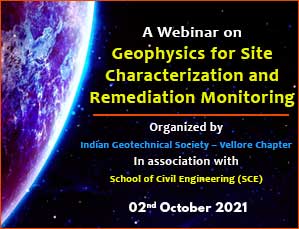- Home
- All Events
- A Webinar on Geophysics for Site Characterization and Remediation Monitoring

A Webinar on Geophysics for Site Characterization and Remediation Monitoring
- 02 Oct 2021
- Webinar
- School of Civil Engineering (SCE)
- Brochure
- Registration Link
Photo Gallery
News Gallery
The uses of geophysical methods to assist in site exploration have been in trend for decades. Various geophysical instruments have been designed to map the spatial variations in the physical properties of the subsurface. Especially, for large engineered structures and sites, the complex and changing subsurface are interpreted to generate sophisticated geological models. Despite being cost-effective, non-invasive and rapid means of obtaining subsurface information the geophysical methods are often criticized due to their uncertainty i.e. anomaly and ambiguity in their data. Thus, the deep knowledge of geophysics and field experience in applied geophysical methods is required to plan, conduct, analyze and interpret successful geophysical surveys in any terrestrial environment.

